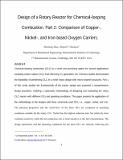Design of a rotary reactor for chemical-looping combustion. Part 2: Comparison of copper-, nickel-, and iron-based oxygen carriers
Author(s)
Zhao, Zhenlong; Ghoniem, Ahmed F
DownloadRotary_CLC_Part2 - final.pdf (2.555Mb)
PUBLISHER_CC
Publisher with Creative Commons License
Creative Commons Attribution
Terms of use
Metadata
Show full item recordAbstract
Chemical-looping combustion (CLC) is a novel and promising option for several applications including carbon capture (CC), fuel reforming, H2 generation, etc. Previous studies demonstrated the feasibility of performing CLC in a novel rotary design with micro-channel structures. Part 1 of this series studied the fundamentals of the reactor design and proposed a comprehensive design procedure, enabling a systematic methodology of designing and evaluating the rotary CLC reactor with different OCs and operating conditions. This paper presents the application of the methodology to the designs with three commonly used OCs, i.e., copper, nickel, and iron. The physical properties and the reactivities of the three OCs are compared at operating conditions suitable for the rotary CLC. Nickel has the highest reduction rate, but relatively slow oxidation reactivity while the iron reduction rate is most sensitive to the fuel concentration. The design parameters and the operating conditions for the three OCs are selected, following the strategies proposed in Part 1, and the performances are evaluated using a one-dimensional plug-flow model developed previously. The simulations show that for all OCs, complete fuel conversion and high carbon separation efficiency can be achieved at periodic stationary state with reasonable operational stabilities. The nickel-based design includes the smallest dimensions because of its fast reduction rate. The operation of nickel case is mainly limited to the slow oxidation rate, and hence a relatively large share of air sector is used. The iron-based design has the largest size, due to its slow reduction reactivity near the exit or in the fuel purge sector where the fuel concentration is low. The gas flow temperature increases monotonically for all the cases, and is mainly determined by the solid temperature. In the periodic state, the local temperature variation is within 40 K and the thermal distortion is limited. The design of the rotary CLC is also scaled to different pressures and inlet temperatures. The method of scaling is discussed and desirable operational performances are obtained.
Date issued
2013-12Department
Massachusetts Institute of Technology. Department of Mechanical EngineeringJournal
Fuel
Publisher
Elsevier
Citation
Zhao, Zhenlong, and Ahmed F. Ghoniem. “Design of a Rotary Reactor for Chemical-Looping Combustion. Part 2: Comparison of Copper-, Nickel-, and Iron-Based Oxygen Carriers.” Fuel 121 (April 2014): 344-360.
Version: Author's final manuscript
ISSN
00162361